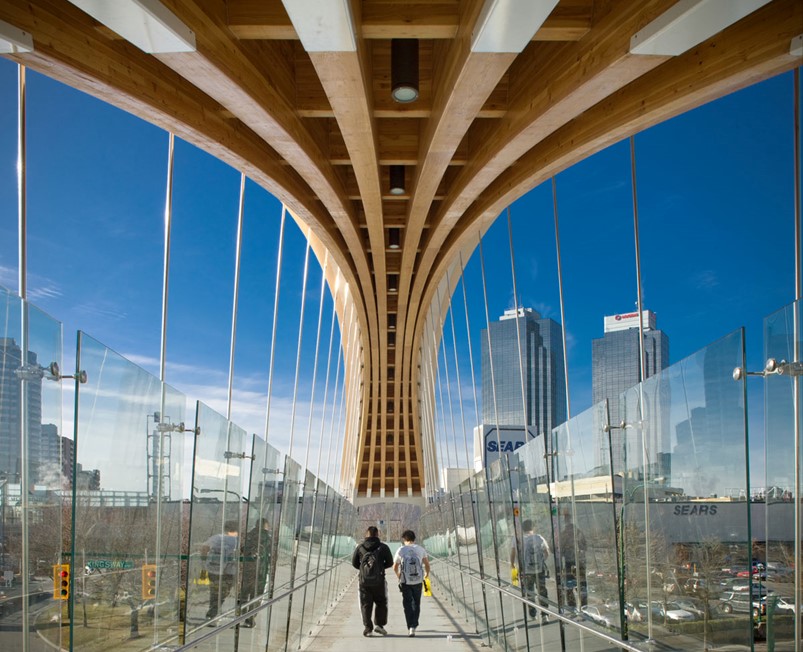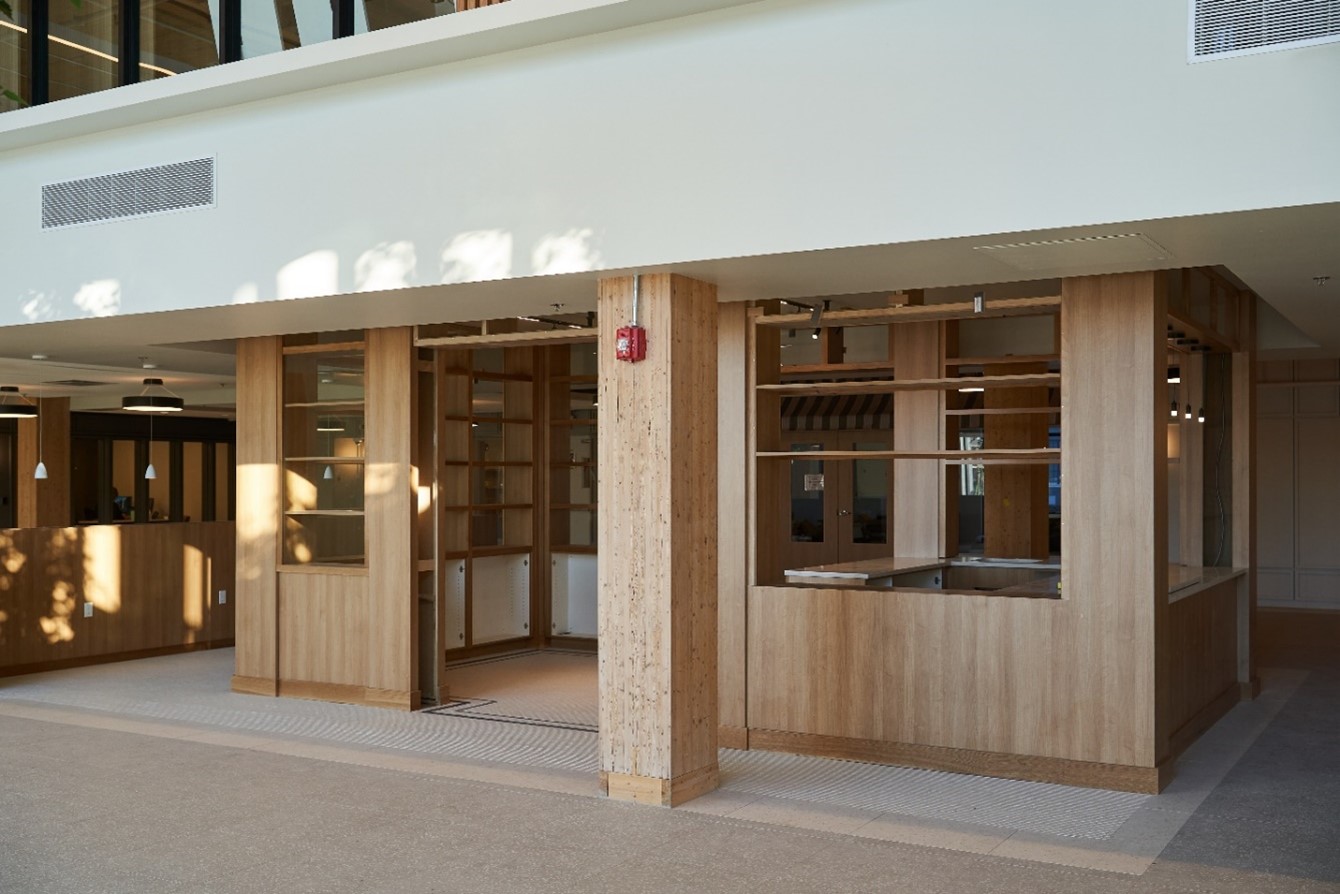Revolutionizing construction and supporting global net zero targets

Something that isn’t well known, is that mass timber is North America’s fasting growing, low-carbon infrastructure solution in the fight against climate change. This is evident in the increasing number of multi-story mass timber buildings emerging on the skyline. The surge is a result of recent adoptions of national building code advancements, permitting mass timber in commercial and residential building classifications to reach 12-storeys in Canada and 18-storeys in the USA.
See PBS feature on 25 storey mass timber tower in Milwaukee, WI
What is mass timber?
Mass timber uses state-of-the-art technology to glue smaller, and sometimes lower quality, pieces of wood into long, laminate in layers, resulting in large structural panels, posts, and beams.
This exceptionally strong, versatile, and light weight construction material is not only incredibly tough, but it also creates buildings that are aesthetically pleasing, drawing people in to see their beauty. Places in Canada like the Calgary Public Library, Kingsway Pedestrian Bridge, and the Riverway Golf Clubhouse are all mass timber. The exposed wood creates a sense of warmth, calm and earthiness to the space.



However, the real magic of mass timber lies in its ability to reduce embodied carbon of infrastructure materials and sequester carbon through the building lifecycle - to support global net zero targets. By merging sustainable forestry practices, carbon sequestration capabilities, and energy-efficient construction techniques, mass timber is paving the way for a greener and more sustainable future in the built environment.
The Advantages of Mass Timber
Mass timber possesses several key advantages that make it a viable alternative to traditional construction materials. It minimizes waste and reduces carbon emissions, demands less specialized labor, and often proves to be more cost-efficient than conventional construction approaches. With an impressive strength-to-weight ratio, merely 1/8th that of concrete, mass timber allows for the construction of robust and sizable structures. Its solid block composition grants inherent fire resistance by hindering the movement of air and fire (National Research Council of Canada), in addition to providing durability against seismic forces. This makes mass timber a safe and reliable choice for architects and engineers.
Sustainability and Carbon Sequestration
The environmental impact of the global construction industry is staggering, with nearly 39 per cent of the annual global CO2 emissions attributed to the built environment, as reported by the World Green Building Council. Despite efforts to reduce building operational emissions (operational carbon) through improvements in energy codes and transitioning to renewable energy sources (a process known as "greening the grid"), addressing the carbon footprint associated with building materials (embodied carbon) remains a significant challenge. Within this context, mass timber emerges as an eco-friendly alternative, emitting 30 percent fewer CO2 emissions compared to concrete buildings and 50 percent less than steel buildings.
One of mass timber’s most significant contributions to global net zero targets is its ability to sequester carbon dioxide. As trees grow, they absorb CO2 from the atmosphere, and when sustainably harvested and used in mass timber construction, they store that carbon throughout the building’s life. This locks in carbon, preventing its release back into the atmosphere. The production of mass timber also requires significantly less energy and generates fewer greenhouse gas emissions compared to traditional construction materials like steel and concrete.
Prefabrication and Reduced Construction Time
Mass timber's prefabrication capabilities have revolutionized the construction processes by reducing project timelines. Precise manufacturing of mass timber components off-site allows for quicker assembly on-site, reducing construction time by up to 25 per cent and reducing site labour by 75 per cent compared to traditional cast in place concrete. This not only minimizes disruption to local communities but also translates into cost savings for developers and governments. Integrating virtual design and construction (VDC) options like building information modeling (BIM) further optimize efficiency and precision.
Urban Densification and Circular Economy
Mass timber supports urban densification efforts, offering an eco-friendly solution for vertical construction in cities. As cities grow and space dwindles, mass timber buildings provide a sustainable alternative to traditional high-rises. Mass Timber also facilitates the principles of a circular economy. Its manufacturing process enhances the economic value of forestry resources by a factor of ten, significantly a substantial increases their economic worth. Additionally, the production process generates minimal waste, and, at the end of a building's life cycle, mass timber components can be reused, repurposed, or recycled, minimizing environmental impact and the need for new materials.

Health and Well-being:
Beyond its environmental advantages, mass timber offers significant social sustainability benefits. Wood interiors create a warm and inviting atmosphere, enhancing occupant satisfaction and productivity. The natural aesthetic qualities of mass timber can positively impact mental health and foster a sense of connection with nature, even in urban settings. The use of wood in construction has also been linked to reduced stress levels, improved indoor air quality, and enhanced thermal comfort, according to the Wood and Human Health Study.
Conclusion:
Mass timber is at the forefront of sustainable construction, revolutionizing the way we build our cities while supporting global net zero targets. Through sustainable forestry practices, carbon sequestration capabilities, and energy-efficient construction methods, mass timber is paving the way for a greener, more sustainable, and more resilient future.
Additional Resources:
Video - Global keynote on mass timber from DfMA perspective - 15min
